Repino, Saint Petersburg
Repino (Russian: Ре́пино) is an area of Saint Petersburg, Russia, and a station of the Saint Petersburg-Vyborg railroad. It was known by its Finnish name Kuokkala until 1948, when it was renamed after its most famous inhabitant, the painter Ilya Repin. It is 30 kilometers (19 mi) northwest of St. Petersburg[5] on the Karelian Isthmus and Gulf of Finland. The population was 2,478 at the 2010 Census.
Repino
Репино | |
|---|---|
Municipal Settlement | |
.png.webp) Flag .png.webp) Coat of arms | |
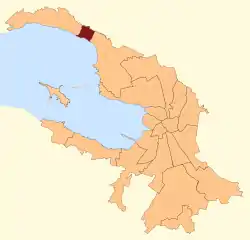 Location of Repino in Saint Petersburg | |
Location of Repino 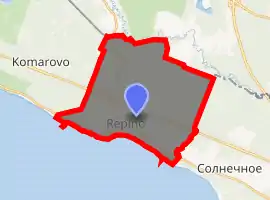
| |
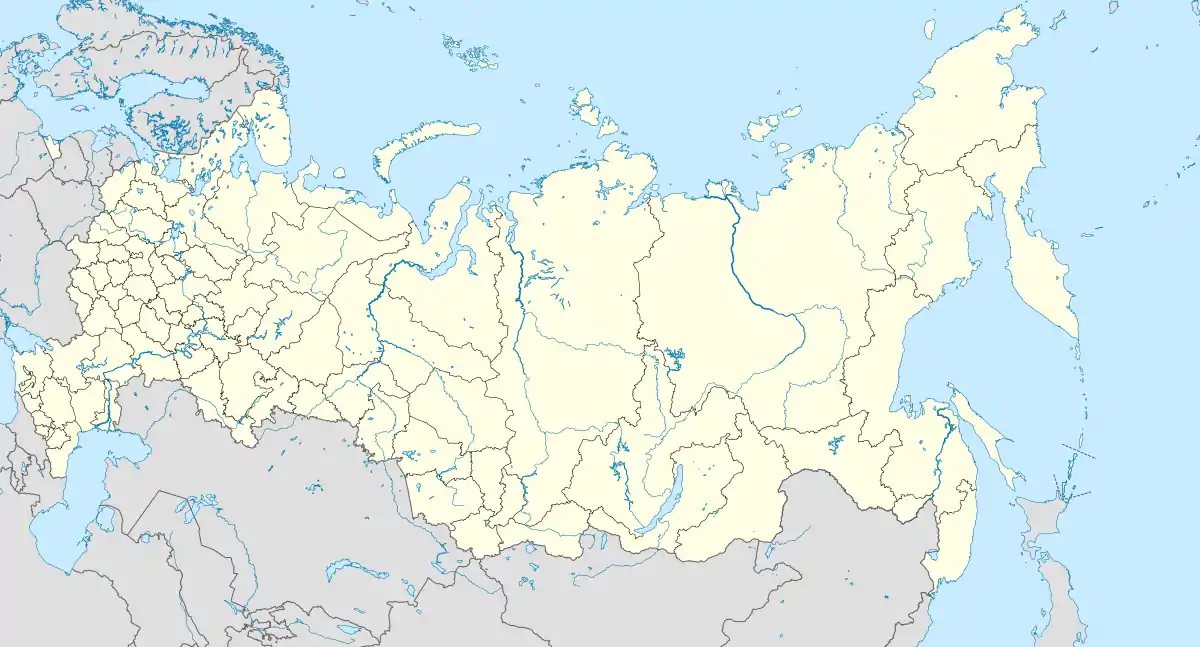 Repino Location of Repino 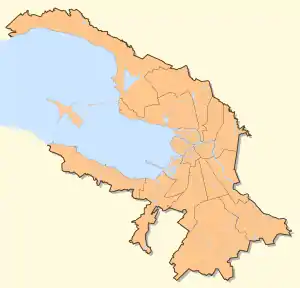 Repino Repino (Saint Petersburg) | |
| Coordinates: 60°10′N 29°52′E | |
| Country | Russia |
| Federal subject | Saint Petersburg |
| Area | |
| • Total | 15.88 km2 (6.13 sq mi) |
| Population | |
| • Total | 2,478 |
| • Estimate (2018)[2] | 2,847 (+14.9%) |
| • Density | 160/km2 (400/sq mi) |
| Time zone | UTC+3 (MSK |
| Postal code(s)[4] | 197738 |
| Dialing code(s) | +7 +7 812 |
| OKTMO ID | 40367000 |
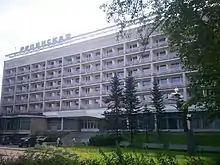
History
The first mention of Kuokkala is in a peace treaty between the Republic of Novgorod and Sweden in 1323. The territory where the village is located was fought over between the Muscovites and Swedes in the 16th and 17th centuries and came under Russian control after the Great Northern War in the early 18th century. The village was inhabited by fishermen of Finnish and Russian ethnicities. The area developed further after 1870 when the railway linking St Petersburg and Helsinki passed through the town. Wealthier residents of St Peterburg built holiday villas in the area and a new railway station was built in 1889. Kuokkala was located in the Grand Duchy of Finland, a self-governing part of the Russian Empire, which had a more liberal environment, attracting artists and intellectuals including the artist Ilya Repin. Lenin spent some time in Kuokkala during 1905 to 1907, staying at the Vasa Villa.
Shortly after the October Revolution in 1917, Finland declared its independence from the Soviet Union and Kuokkala became part of the new independent nation while retaining a significant ethnic Russian population. There was a skirmish between White and Red Finns at Kuokkala during the Finnish Civil War on 28 April 1918. Kuokkala was taken over by the Soviets when the Karelian Isthmus was ceded by Finland to the Soviet Union after the Winter War (1939–1940) and the Continuation War (1941–1944). Kuokkala became a part of the Leningrad Oblast in 1948 and was renamed Repino in memory of the painter Ilya Repin.[5] After the war, the area was developed as a tourist area with several hotels and sanatoriums and was transferred to the jurisdiction of the city of St Petersburg as part of the Kurortny District
Penates
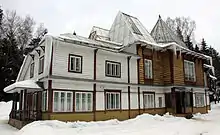
In 1899, Repin bought an estate here and called it Penaty (Russian: Пенаты, meaning Penates, Roman household deities). He designed his own house, and after it had been built several years later, Repin moved to Kuokkala. He would live there until his death in 1930. The house is surrounded by a large park.
The estate is part of the UNESCO World Heritage Site "Saint Petersburg and Related Groups of Monuments".[6] The estate has been a museum since 1940.[7]
Famous inhabitants
- Mikhail Botvinnik, World chess champion, was born in Kuokkala in 1911.
- Vladimir Lenin, Russian Communist leader and founder of the USSR, lived in Kuokkala between 1906 and 1907.
- Ivan Puni, avant-garde artist, was born in Kuokkala in 1894.
- Ilya Repin, painter and sculptor, lived in Kuokkala from the beginning of the 20th century until his death in 1930.
- Korney Chukovsky, children's poet and philologist, lived in Kuokkala from 1906 till 1916.
- Elena Mrozovskaya, an early female photographer, died in Kuokkala in 1941.[8]
- Dmitri Shostakovich, Soviet composer, went to Cottage #20 at the Composers' Union Resort, located in Repino, to relax and compose, every year from 1961 to 1975.[9]
- In 2018, Repino was the base for the England team for the 2018 FIFA World Cup that was held in Russia.
Notes
- Russian Federal State Statistics Service (2011). "Всероссийская перепись населения 2010 года. Том 1" [2010 All-Russian Population Census, vol. 1]. Всероссийская перепись населения 2010 года [2010 All-Russia Population Census] (in Russian). Federal State Statistics Service.
- "26. Численность постоянного населения Российской Федерации по муниципальным образованиям на 1 января 2018 года". Federal State Statistics Service. Retrieved 23 January 2019.
- "Об исчислении времени". Официальный интернет-портал правовой информации (in Russian). 3 June 2011. Retrieved 19 January 2019.
- Почта России. Информационно-вычислительный центр ОАСУ РПО. (Russian Post). Поиск объектов почтовой связи (Postal Objects Search) (in Russian)
- (in German) Petersburg-Aktuell, "Repino: Zu Gast beim großen Meister", retrieved on 25 May 2007.
- Unesco World Heritage Site Saint Petersburg and Related Groups of Monuments, retrieved 25 May 2007.
- Info on the museum "Penates", retrieved 25 May 2007.
- Pachmuss, Temira (1992), A moving river of tears: Russia's experience in Finland, American university studies: Slavic languages and literature, 15, P. Lang, p. 173, ISBN 9780820419565,
Elena Lukinichna Mrozovskaya, an artistic photographer in St. Petersburg, had a house in Vammelsuu in the 1920s; in 1941 she died in Kuokkala, after the Soviet-Finnish War of 1939-40.
- http://www.katyachilingiri.com/shostakovich.html
.svg.png.webp)